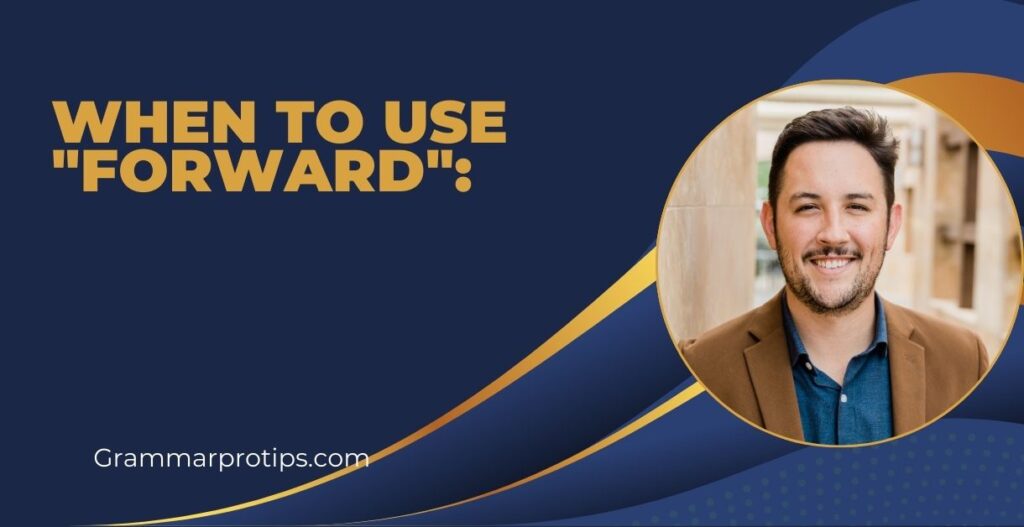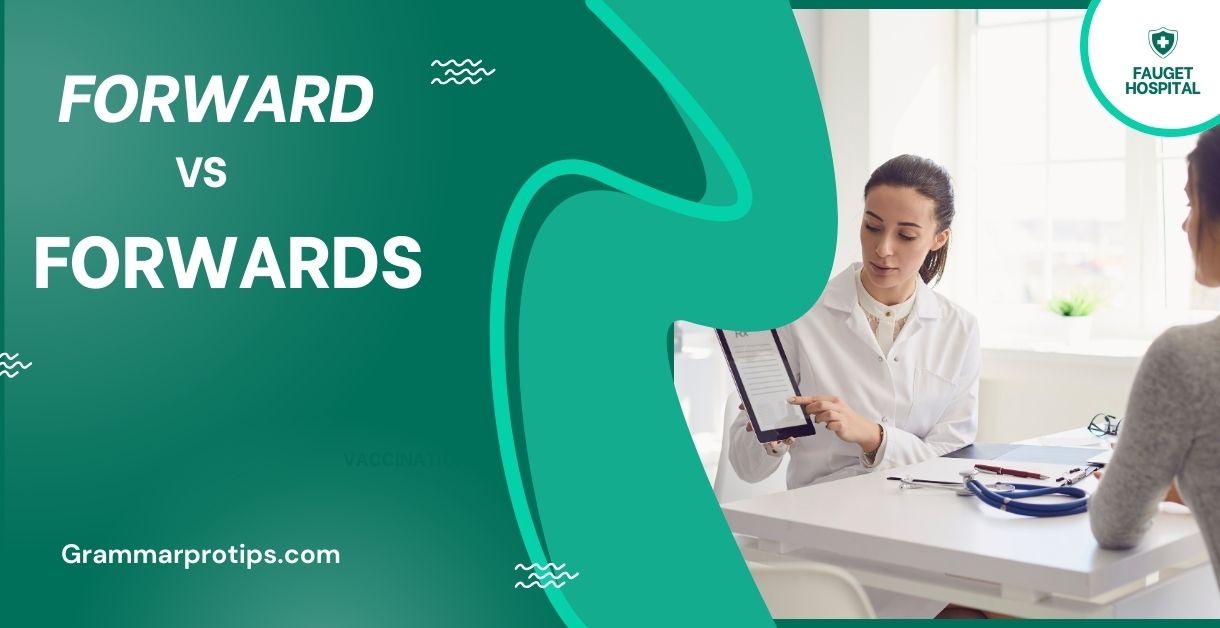The English language can be tricky, especially when it comes to seemingly simple words like “forward” and “forwards.” While they might seem interchangeable, subtle differences in usage can make your writing or speech sound more polished and appropriate for different contexts.
Understanding when to use “forward” vs. “forwards” will not only improve your grammar but also enhance your communication, whether you’re writing a formal email or speaking casually with friends.
Forward vs. Forwards: What’s the Difference?
First off, let’s tackle the difference between forward and forwards.
The main distinction between forward and forwards lies in the adverbial function. Technically, both words are adverbs that indicate direction. However, their usage can depend on regional language differences, context, and even formality.
Forward as an Adverb:
When we use forward, it often carries a more formal tone, and it’s generally used in American English. For example:
- “We need to move forward with this project.”
- “Please step forward.”
Forwards as an Adverb:
On the other hand, forwards tends to be used in more informal or casual settings and is more common in British English. For example:
- “The team is pushing forwards with the new initiative.”
- “We look forwards to your feedback.”
Now, don’t worry too much about these distinctions—there are plenty of cases where both words work in similar contexts, but paying attention to the nuance will help you sound more polished.
Moving Forward or Moving Forwards?
One common scenario where people get stuck is deciding whether to say “moving forward” or “moving forwards.” In business communication or formal writing, moving forward is generally the preferred phrase. It sounds cleaner and more professional.
Example:
Email Scenario: Subject: Moving Forward with Our Partnership
Dear Sarah,
Thank you for your prompt response. After reviewing the proposal, we are excited to move forward with the partnership. We believe this collaboration will be mutually beneficial, and we look forward to working with you closely.
Best regards,
John
In this case, moving forward sounds more appropriate because it’s a formal business email. However, in a more casual conversation, moving forwards could work just as well.
Looking Forward or Looking Forwards?

The phrase looking forward to is often used in emails, business communication, and even casual conversations. You might hear both looking forward and looking forwards, but there’s a subtle difference in how they’re perceived in American vs. British English.
In American English, looking forward is the more commonly used phrase, while in British English, looking forwards might be slightly more acceptable, though not as widely used.
Example 1: Formal Context
Email Scenario: Subject: Looking Forward to Your Response
Dear Mr. Thompson,
I appreciate your insight into the matter at hand. We are looking forward to the next steps in our discussions and hope to conclude everything soon.
Best regards,
Emily
In this formal email, “looking forward” sounds more natural and professional.
Example 2: Informal Context
Casual Conversation: Person 1: “I can’t wait to see you this weekend!” Person 2: “Me neither! I’m really looking forwards to it.”
In this more informal scenario, looking forwards might come across as a bit more casual, but it’s perfectly acceptable in speech.
Going Forward or Going Forwards?
Similar to moving forward and moving forwards, the phrase going forward is typically used in more formal writing or business settings, whereas going forwards might be heard in more casual conversation or British English.
Example 1: Formal Context
Email Scenario: Subject: Going Forward with Our Strategy
Dear Team,
As we continue to refine our business strategy, we’ll need to ensure that we’re all aligned. Going forward, we will focus on expanding our digital presence.
Best regards,
Jake
Here, going forward fits the tone and context of the email.
Example 2: Informal Context
Casual Conversation: Person 1: “We’ve made a lot of progress with the new project.” Person 2: “Yes, and going forwards, we’ll need more resources.”
This informal chat feels natural, and going forwards works well in the context.
Forward vs. Forwards: Which One Should You Use?
So, which is the correct choice when deciding between forward vs. forwards? The answer largely depends on a few factors, including formality, regional differences, and the specific context.
When to Use “Forward”:

- In formal writing (business emails, reports, official communication)
- In American English, where “forward” is the more common choice
- To maintain clarity and professionalism
When to Use “Forwards”:
- In casual or informal contexts (casual conversations, relaxed emails)
- In British English, where “forwards” can sound more natural
- To convey a more conversational tone
Quick Tip:
If you’re ever unsure, it’s safe to default to forward in formal contexts and forwards in informal speech. Both are grammatically acceptable, but adjusting based on the situation will make your communication sound more natural and appropriate.
Adverbs and Their Role in the English Language
Let’s take a quick look at adverbs and how they function in English. Adverbs modify verbs, adjectives, or other adverbs, helping us describe actions or states more specifically. In this case, forward and forwards are both adverbs that describe movement or direction.
In general, adverbs can have different forms—sometimes ending in -ly (e.g., quickly, happily) and sometimes not (e.g., fast, forward). While forward is a more formal adverb, forwards can still be used to convey similar meaning in a more relaxed tone.
Regional English Differences: American vs British
One of the most significant factors influencing whether you use forward or forwards is regional English differences. Both American English and British English have their own preferences.
- In American English, forward is typically preferred in both casual and formal contexts. So, phrases like “moving forward,” “looking forward,” and “going forward” are more common.
- In British English, you’ll find that forwards is often used, particularly in more casual contexts. You might hear people say “moving forwards” or “looking forwards” in everyday speech.
Formal vs Informal Language: What’s Best for You?

The choice between forward vs forwards can also hinge on whether your communication is formal or informal. Here are some tips:
Formal Language Style
In formal settings, such as business communication, official letters, or academic papers, it’s generally better to stick to forward. For example:
- “We need to move forward with the proposal.”
- “I look forward to hearing from you soon.”
Informal Language Style
In casual conversation or informal writing, forwards may feel more natural. For example:
- “I’m excited to move forwards with our plans!”
- “We’re looking forwards to seeing you this weekend.”
Common English Mistakes: Forward vs Forwards
It’s easy to confuse forward with forwards because they are both commonly used to describe direction. However, overusing one or the other in the wrong context can lead to mistakes that make your writing or speech sound awkward or imprecise.
Here are some common mistakes to avoid:
- Using forwards in formal settings when forward is the preferred term.
- Saying “going forwards” in a professional email when “going forward” is more appropriate.
- Overusing forwards in informal speech without considering whether it aligns with the regional dialect.
Example Table: Forward vs. Forwards in Different Contexts
| Context | Preferred Usage |
|---|---|
| Business Email | Forward |
| Casual Conversation | Forwards |
| British English | Forwards |
| American English | Forward |
| Formal Writing | Forward |
| Informal Speech | Forwards |
Conclusion: Forward or Forwards?
When deciding between forward vs forwards, the right choice depends on the formality of your language, the regional variation (American or British English), and the context in which you’re speaking or writing.
In most formal situations, especially in business communication, forward is the better choice, while forwards works well in informal or conversational settings. Regardless of which one you use, always strive to sound natural and clear, whether you’re looking forward to an event or moving forward with
your plans.
Ultimately, understanding these subtle differences will enhance your grammar and make your communication more effective. So next time you’re choosing between forward vs forwards, consider the tone, audience, and context—and you’ll be on your way to more confident communication!
This guide should help you confidently navigate the nuances between forward and forwards in a variety of contexts. If you’re still unsure, check out some online discussions, like those on Reddit (e.g., forward vs forwards which one should you use reddit), to get a sense of how others approach the topic. Happy writing!

“Smith is the dedicated admin of [grammarprotips.com], a platform focused on enhancing grammar skills. With a passion for language and education, Smith strives to make grammar accessible and enjoyable for learners of all levels. Committed to delivering high-quality content, Smith continually explores innovative ways to help users master the complexities of grammar.”

